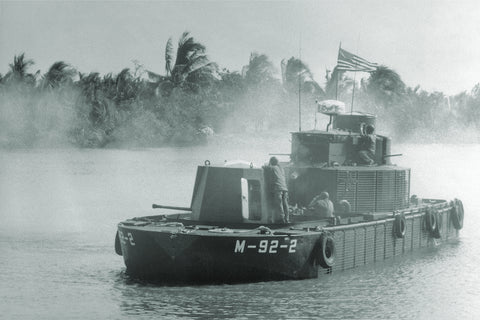
All You Need to Know About Riverine Operations in Vietnam
Riverine warfare was a central element of combat in Vietnam. The French and Viet Minh struggled for control of the Red and Black Rivers. Later, the South Vietnamese and Americans contested with the Viet Cong for the lower Mekong and its tributaries. With 15,600 square miles of land and more than 15,000 miles of waterways, the Mekong Delta was of vital strategic importance. Producing some 16 million tons of rice per year, the Delta was the foundation of the Republic of Vietnam’s economy. For the communists, the Mekong River running south from Cambodia was the southernmost branch of the Ho Chi Minh Trail, bringing vital support to 28 VC battalions and 69 separate companies in the Delta, totaling some 82,500 troops.
By 1966 the communists controlled almost 25 percent of the Delta’s population, and their primary objective was to cut off the South’s rice supply. The twofold objective of the allies was to sever the flow of supplies to the VC, and eliminate VC forces and infrastructure. The U.S. Navy’s lighter patrol forces of Task Forces 115 and 116 patrolled the Mekong, Co Chien, Long Tau, and Bassac Rivers and their tributaries to deny the use of those waters to the VC.
Army-Navy Patrols
TF 117, also known as the Mobile Riverine Force (MRF), was the striking arm of the joint Army-Navy riverine warfare campaign. Established in late 1966, the MRF was based closely on the French Dinassauts ( Divisions Navales d’Assaut ), integrated units of naval and army forces established for riverine warfare in the late 1940s. The MRF’s ground combat element would have been a natural mission for the U.S. Marine Corps, but all the Marines in South Vietnam were deployed in the north.
The mission fell to the 9th Infantry Division’s 2nd Brigade. Initially, TF 117 only had capacity to maintain and transport two battalions at any time. The battalions rotated, with one maintaining security for their base camp at Dong Tam. The Navy component of the MRF was River Assault Flotilla 1, initially consisting of the 9th and 11th River Assault Squadrons.
Each squadron could carry a battalion. Many of TF 117’s boats were modified conversions of World War II-era Landing Craft Mechanized-6 (LCM-6), and included armored troop carriers, heavily armed monitors for fire support, and radar-equipped command boats.
An important innovation was mounted field artillery on barges, increasing the mobility and operational range of the artillery battalion. Each barge carried two 105mm howitzers, crews, and ammunition. Field artillery requires stationary firing platforms and fixed aiming points, which meant that the barges had to be beached and secured along a waterway bank to fire effectively.
this article first appeared in vietnam magazine
The most significant riverine operations were the CORONADO I through XI series from June 1967 to July 1968. Initially the MRF’s tactics surprised the VC. Accustomed to defending against attacks from land and air, VC defenses initially faced away from water. But the VC adapted quickly. While underway, principal security threats to the MRF came from command-detonated mines in the centers of the channels.
Mines and Suicide Boats
Hugging shorelines brought boats closer to land ambushes with heavy fire from recoilless rifles and B-40 rockets. While anchored, the most critical threats were from floating mines, swimmer saboteurs, and suicide attack boats.
The 2nd Brigade had to operate with only two battalions instead of three, depriving the brigade commander of the ability to attack with the standard one-third of his force in reserve. It also took time to get the attack force in position to make the landings. The afloat force could only move at a speed of 6 to 10 knots, indicating to the VC that an attack was coming. Typical operations lasted two to four days. Once ashore, the main tactical problem was to seal off the objective area to prevent VC from escaping.
When the troops disembarked, the boats moved to blocking positions along nearby waterways to prevent VC from using them to withdraw. But the VC quickly learned the drafts of TF 117’s various boats and took up positions secured partially by streams too shallow for the boats to navigate. That made it almost impossible for the assault force to encircle the objective completely.
Marshy ground and numerous intersecting waterways made it difficult to move fast on foot. Helicopters solved that problem, with part of the assault force landing in the VC rear. Helicopter assets were always at a premium, however; forces north of the Delta often had higher priority. As time went on, the VC became more elusive and difficult to engage decisively.
This story appeared in the 2023 Autumn issue of Vietnam magazine.
historynet magazines
Our 9 best-selling history titles feature in-depth storytelling and iconic imagery to engage and inform on the people, the wars, and the events that shaped America and the world.
